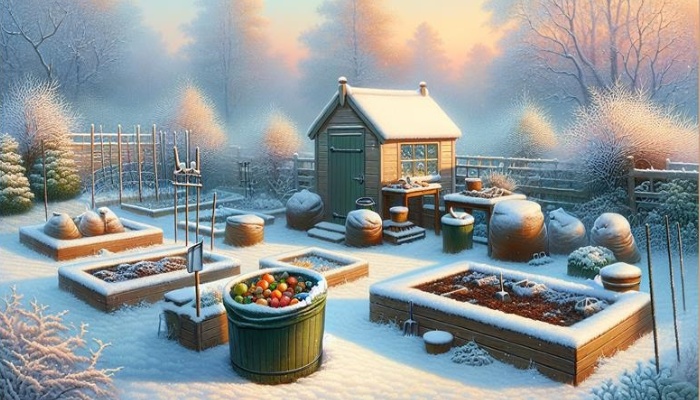To winterize your square foot garden quickly and easily, first, test your soil’s pH and nutrient levels with a kit from your local garden center. Adjust your watering schedule to avoid overwatering and maintain moisture for root protection.
Next, choose the right mulch; organic mulches like straw not only retain moisture but also improve soil fertility.
Consider planting cover crops like clover or cold-hardy veggies such as kale and spinach to enrich the soil and extend your gardening season.
Protect your plants from frost with blankets or heating cables, and continue monitoring soil pH and moisture throughout winter. With these steps, you’ll ensure your garden survives the colder months and is ready for spring’s arrival.
Assess Your Garden’s Needs
Before you begin winterizing your square foot garden, first evaluate its specific needs, considering factors like plant varieties, local climate conditions, and soil health.
One of the first steps you should take is to conduct soil testing. This isn’t as daunting as it sounds. Simple kits from your local garden center can tell you exactly what your soil lacks or has in excess.
Knowing your soil’s pH and nutrient levels can help you adjust them for winter to ensure that your perennials, bulbs, and cold-hardy crops have the best chance to thrive.
Another vital aspect to assess is your watering schedule. As temperatures drop, your garden’s water needs will change.
Overwatering can be just as detrimental in the colder months as it is during the growing season, leading to root rot and other issues.
You’ll want to reduce your watering frequency, but don’t let your garden go completely dry, especially if you’re expecting a freeze. The moisture in the soil can provide some insulation against the cold, protecting the roots of your plants.
Selecting Appropriate Mulch
Mulch serves as a protective layer, shielding your soil from the harsh winter elements. It helps retain soil moisture, suppresses weed growth, and adds valuable nutrients back into the soil as it decomposes.
With a variety of mulch types available, selecting the right one for your garden is key.
Organic mulches, such as straw, leaves, or wood chips, are excellent choices. They not only insulate the soil, keeping it warmer during cold snaps, but they also break down over time, improving soil structure and fertility.
Straw is particularly easy to spread and ideal for square foot gardens due to its light weight and ease of handling.
Inorganic mulches, like black plastic or landscape fabric, can also be used. These materials are effective at weed suppression and warming the soil. However, they don’t offer the same soil-enhancing benefits as organic mulches.
Assess the specific needs of your square foot garden, and choose a mulch that offers the best protection and soil improvement properties.
Planting Winter Crops
Winter crops aren’t just about extending your gardening season; they play a big role in soil health and preparation for the next growing season.
Consider planting cover crops, such as clover or winter rye. These aren’t just placeholders; they’re hardworking plants that fix nitrogen in the soil, improving its fertility.
As they grow, cover crops also suppress weeds and protect your soil from erosion during harsh winter conditions. Before spring, you’ll simply turn these crops into the soil, adding valuable organic matter that acts as natural soil amendments.
Planting cold-hardy vegetables like kale, spinach, and broad beans that can withstand cooler temperatures, provides you with a fresh harvest even in the colder months.
These crops not only provide fresh produce but also keep your garden active, reducing the need for extensive soil amendments in spring.
Protecting Plants From Frost
As temperatures drop, protect your garden’s hard work from frost, ensuring your plants survive the cold season intact. Here are some effective strategies:
- Frost blankets: These are specially designed to keep the cold away from your plants. Drape them over your crops in the evening when frost is predicted, and remove them in the morning once the sun is up. This helps to trap heat and prevent the cold air from damaging your plants.
- Heating cables: Installing heating cables around your square foot garden provides a consistent heat source, preventing the soil from freezing. It’s an investment that can pay off by extending the growing season.
- Watering in the evening: Surprisingly, watering your plants in the late afternoon or early evening before a frost night can help. The water releases heat slowly overnight, preventing the ground and the plant cells from freezing.
- Mulching: Applying a thick layer of organic mulch around your plants acts as an insulation layer, keeping the soil temperature more stable and protecting the roots from freezing.
Maintenance Through Winter
To ensure your square foot garden thrives through the winter, it’s essential to maintain a regular, tailored care routine for your plants during the colder months. Monitoring soil pH is a critical aspect of this maintenance.
Winter weather can significantly alter the soil’s acidity or alkalinity, affecting plant health. Purchase a simple testing kit from your local garden store, and check your garden’s soil pH every few weeks.
If you find it’s drifted too far from the ideal range for your plants, you’ll need to adjust it. Adding lime can raise the pH, and sulfur can lower it, helping your plants absorb nutrients more efficiently even in chilly conditions.
Pest control shouldn’t be neglected in winter, either. Many assume cold weather eliminates pests, but some can survive and damage dormant plants.
Regularly inspect your garden for signs of infestation. If you spot trouble, consider using organic pest control methods to keep your garden healthy without harming the environment.
For instance, neem oil is an effective, natural pesticide that won’t introduce harsh chemicals to your garden.

